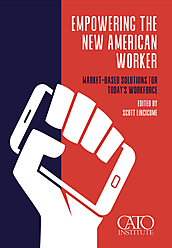Homeownership

Introduction
Ensuring a Sound Macroeconomic Foundation
Facilitating Personal Improvement
Enabling Mobility and Independence
Improving Living Standards
Conclusion
The U.S. government has become increasingly involved in housing finance since the 1930s. While the perceived success of this involvement has helped create the belief that the private housing market cannot properly function without extensive federal involvement, the historical record demonstrates the opposite. Robust mortgage financing exists in virtually every developed nation of the world without the degree of government involvement found in the United States. Yet, as shown in Figure 1, the U.S. homeownership rate remains below average among developed nations: 64.2 percent in the United States versus 71.1 percent for Organisation for Economic Co-operation and Development (OECD) countries.1
Furthermore, even though the U.S. ownership rate has changed little since the 1960s, volatility of American home prices and construction were among the highest in the industrialized world from 1998 to 2009.2
The United States is the only major country in the world with a federal government mortgage insurer, government guarantees of mortgage securities, and government-sponsored enterprises (GSEs) in housing finance. As of 2010, comparing the United States with 11 other industrialized countries, only two have a government mortgage insurer (Netherlands and Canada); two have government security guarantees (Canada and Japan); and two have GSEs (Japan and Korea).3 Denmark even maintains a prepayable fixed-rate 30-year mortgage without the need for GSEs or other government support, and at a lower cost to borrowers than in the United States.4
Most federal intervention in housing finance boosts demand, typically by making it easier to obtain a home mortgage. Federal policies encourage borrowing by supporting the operations of Fannie Mae, Freddie Mac, Ginnie Mae, and the Federal Home Loan Banks and by providing loan insurance through the Federal Housing Administration (FHA), the Veterans Affairs (VA) home-lending program, and the U.S. Department of Agriculture’s Rural Development Program. Prior to the 2008 financial crisis, the federal government controlled a dominant share of the housing finance system, and that share has since expanded. The operations of Fannie and Freddie (the two main GSEs) and the FHA account for the bulk of this federal intervention.
As of December 31, 2020, Fannie and Freddie had combined total assets of $6.6 trillion, representing approximately 42 percent of the nation’s outstanding mortgage debt.5 From 2008 to 2019, the FHA’s annual market share of purchase loans ranged from 16.5 percent to 32.6 percent.6 From 2009 to 2020, Fannie and Freddie’s annual share of the total mortgage-backed security (MBS) market averaged 70 percent. Including Ginnie Mae securities, those that are backed by FHA mortgages, the federal share of the mortgage-backed security market averaged 92 percent per year.7
Rather than increase homeownership, the FHA has accelerated it for individuals who would otherwise obtain home loans later in the conventional market. Similarly, Fannie and Freddie have cost federal taxpayers billions of dollars and done little to measurably increase homeownership rates. The GSEs have, however, helped to enrich the politically connected and to increase both consumer debt and housing prices, putting sustainable homeownership out of reach for many lower-income households. The wedge between wage gains and home price appreciation, driven largely by government-induced leverage in housing markets, has been especially large for lower-priced homes (see Figures 2 and 3.) After the GSEs imploded in 2008, triggering a major recession and financial crisis, Congress could have shut them down. Instead, Congress chose to prop up the companies indefinitely, and now they remain under government conservatorship.
Broadly, federal policy should not prioritize owning a home. Even where homeownership has been shown to correlate with positive spillover effects, such as lower crime and better schools, it has not been shown to cause those spillovers. Regardless, even if homeownership did cause such spillovers, it would not follow that everyone should own a home. Buying a home—even without a mortgage—is risky for anyone with variable income or job prospects, and it imposes costs, such as taxes, insurance, and maintenance, that renters would otherwise not incur. Homeownership also can inhibit geographic mobility, especially for people with significant mortgage debt or living in struggling localities. Analyzing data from the Netherlands, Bernstein and Struyven (2022) suggested that, in fact, that having a mortgage can be a serious impediment to geographic mobility when a loan exceeds a home’s value (known as “negative equity,” which often occurs during economic downturns).8 Moreover, even in the absence of the FHA, the GSEs, and other federal programs, there would be no “correct” level of homeownership to target.
Nevertheless, countless government efforts to boost homeownership have not been successful and have instead tended to increase only mortgage ownership. Even as federal intervention in housing finance has steadily increased, the overall rate of homeownership has remained nearly constant over the past 50 years.9 According to the Census Bureau, the homeownership rate was 64 percent in 1970. That is basically where it hovered for most of the 1980s and 1990s, higher than where it bottomed out in 2016, and almost exactly where it stood in the middle of 2019.10 At the same time, the level of residential mortgage debt has increased more than fivefold—Federal Reserve data show that inflation-adjusted mortgage debt increased from about $3 trillion in 1970 (two years after Fannie Mae became a GSE) to $15.8 trillion in 2019.
The Policy Proposals
Get the federal government out of housing finance
Federal policies have caused American workers to take on more long-term fixed-debt obligations while not increasing their net homeownership. This arrangement endangers workers’ ability to build wealth and accumulate assets, especially in turbulent labor markets. Workers have also been paying more for housing because the increased use of long-term debt at lower interest rates has caused home prices—even those that are used for rental homes—to rise more than they would have otherwise. Evidence also suggests that these federal housing policies have created additional incentives for workers to remain in a particular geographic location—a “lock-in effect”—rather than relocate to adapt to changing job markets.11
Thus, the ideal solution would be to remove the federal government entirely from the housing finance industry. Many foreign governments are minimally involved in housing finance, and there is no “market failure” in this industry that necessitates government intervention. Should policymakers nevertheless insist on some level of federal involvement in the market, several discrete reforms are recommended in the following section. These reforms would help American workers by reducing home price growth and rental rates, lowering total consumer debt and increasing consumers’ net worth, and providing more flexibility to move as job market conditions change.
Action Plan
Multiple agency-level reforms can help reduce federal involvement in housing finance to the benefit of American workers. Ultimately, though, major reductions in the level of federal involvement will require Congress to act.
Thus, Congress should
-
limit the FHA’s single-family insurance portfolio to first-time homebuyers, without any refinance eligibility over the tenure of the loans in force. Additionally, the value of loan limits eligible for FHA single-family mortgage insurance should decrease to (at most) the first quartile of home prices in a given locality;
-
end FHA multifamily mortgage insurance;
-
at a minimum, reduce the FHA’s level of loan coverage in the single-family mortgage insurance program from the current level (approximately 100 percent of the loan) to the private industry standard of 20 percent;
-
eliminate any semblance of affordable housing goals for all financial institutions;
-
eliminate the ability-to-repay standard, the qualified mortgage standard, and all the mortgage servicing rules imposed by the Dodd–Frank Act; and
-
shut down Fannie Mae and Freddie Mac and all their subsidiaries. Any legislation to close Fannie and Freddie should avoid creating a smaller version of the GSEs under a new name;
While the GSEs continue to exist, the Federal Housing Finance Agency should
-
raise Fannie and Freddie’s mortgage guarantee fees; and
-
eliminate the geographic price differentials for the GSEs’ conforming loan limits, narrow the GSEs’ focus to the financing of primary homes, and gradually reduce conforming loan limits. (The GSEs should no longer support financing for second homes, vacation homes, investment properties, or cash-out refinancing.)

This work is licensed under a Creative Commons Attribution-NonCommercial-ShareAlike 4.0 International License.

